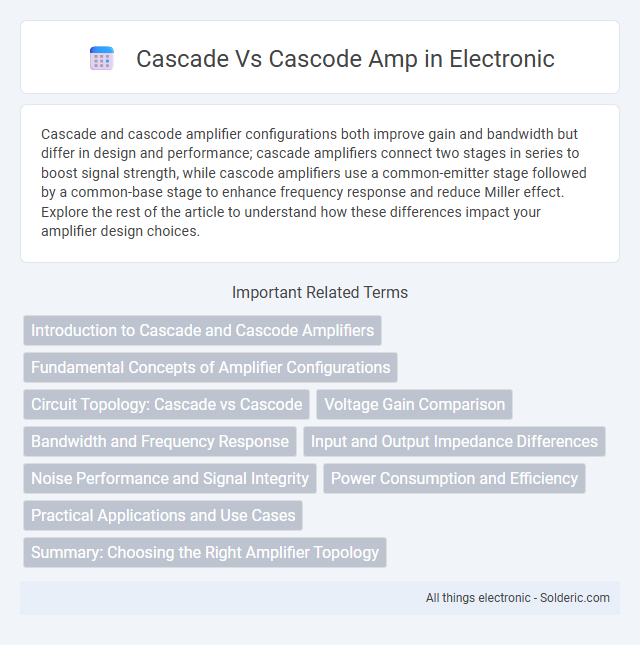Cascade and cascode amplifier configurations both improve gain and bandwidth but differ in design and performance; cascade amplifiers connect two stages in series to boost signal strength, while cascode amplifiers use a common-emitter stage followed by a common-base stage to enhance frequency response and reduce Miller effect. Explore the rest of the article to understand how these differences impact your amplifier design choices.
Comparison Table
| Feature | Cascade Amplifier | Cascode Amplifier |
|---|---|---|
| Configuration | Multiple transistors connected in series, typically common emitter or common source stages. | Common emitter (or source) stage followed by a common base (or gate) stage stacked vertically. |
| Gain | Moderate gain, product of individual stage gains. | High gain due to low Miller effect and better bandwidth. |
| Bandwidth | Reduced bandwidth from Miller capacitance multiplying effect. | Improved bandwidth by minimizing Miller capacitance impact. |
| Input Impedance | Relatively high input impedance. | Moderate input impedance, lower than cascade. |
| Output Impedance | Moderate output impedance. | High output impedance, suitable for current sourcing. |
| Use Cases | General amplification requiring moderate gain and bandwidth. | RF amplifiers, low-noise preamplifiers, and high-frequency circuits. |
| Complexity | Simple to implement with multiple stages. | More complex layout due to stacking and biasing requirements. |
| Miller Effect | Significant Miller capacitance affecting bandwidth. | Reduced Miller effect inherent to cascode design. |
Introduction to Cascade and Cascode Amplifiers
Cascade amplifiers consist of multiple stages of common-emitter or common-source amplifiers connected sequentially, enhancing overall voltage gain and bandwidth by amplifying signals in steps. Cascode amplifiers combine a common-emitter (or common-source) stage with a common-base (or common-gate) stage, significantly improving gain, input-output isolation, and frequency response by reducing the Miller effect. Understanding these configurations helps you select the optimal amplifier design for high-frequency circuits requiring stability and high gain.
Fundamental Concepts of Amplifier Configurations
Cascade amplifiers connect multiple amplifier stages in series to increase overall gain by summing individual stage gains, optimizing voltage amplification while maintaining bandwidth. Cascode amplifiers combine common-emitter (or common-source) stages with common-base (or common-gate) stages to reduce Miller capacitance, improving high-frequency response and stability. Fundamental to both configurations are transistor arrangements that balance gain, bandwidth, and output impedance for efficient signal amplification in analog circuits.
Circuit Topology: Cascade vs Cascode
Cascade and cascode amplifier topologies differ fundamentally in their configuration and performance characteristics. A cascade amplifier stacks two or more transistor stages in sequence to increase overall gain, while the cascode configuration combines a common-emitter (or common-source) stage with a common-base (or common-gate) stage to enhance bandwidth and reduce Miller effect. Understanding the distinct roles of each topology helps you select the appropriate amplifier design for high gain or high-frequency applications.
Voltage Gain Comparison
Cascade amplifiers often achieve higher voltage gain by stacking multiple transistor stages, which increases the overall gain proportionally, while cascode amplifiers provide moderate gain with enhanced bandwidth and gain stability due to the low Miller effect. Cascode configurations improve voltage gain linearity and frequency response by isolating input and output, but the overall voltage gain is usually lower than the cascade topology's cumulative stage gains. Voltage gain in cascade amplifiers is directly influenced by each transistor stage's gain, typically resulting in larger total gain compared to the single-stage gain multiplication of cascode amplifiers.
Bandwidth and Frequency Response
Cascade amplifiers typically offer higher gain but suffer from reduced bandwidth due to cumulative parasitic capacitances affecting the frequency response. Cascode amplifiers improve bandwidth and frequency response by minimizing the Miller effect through a two-stage configuration where a common-emitter is stacked with a common-base transistor. This arrangement results in higher gain-bandwidth product, making cascode amplifiers preferable for high-frequency applications.
Input and Output Impedance Differences
The cascade amplifier exhibits higher input impedance due to the initial stage's common-collector configuration, which buffers the input signal effectively. In contrast, the cascode amplifier, combining a common-emitter followed by a common-base stage, offers lower input impedance but significantly higher output impedance, enhancing voltage gain and bandwidth. This fundamental distinction influences the choice of amplifier topology in applications demanding specific impedance matching and frequency response characteristics.
Noise Performance and Signal Integrity
Cascade amplifiers generally offer improved noise performance by utilizing multiple gain stages in series, thereby reducing overall noise figure and enhancing signal-to-noise ratio. Cascode amplifiers provide superior signal integrity through higher output impedance and reduced Miller capacitance, which increases bandwidth and minimizes distortion. The cascode configuration also benefits noise performance by isolating the input transistor from output voltage variations, resulting in lower input-referred noise compared to simple cascade stages.
Power Consumption and Efficiency
Cascade amplifiers exhibit moderate power consumption due to their configuration of multiple amplifier stages connected sequentially, which can introduce cumulative voltage drops and increased current usage. Cascode amplifiers typically offer higher power efficiency by combining a common-emitter stage with a common-base stage, reducing Miller capacitance and enabling higher gain with lower power dissipation. The cascode configuration's improved frequency response and gain-bandwidth product often result in better overall efficiency compared to cascade amplifiers in high-frequency applications.
Practical Applications and Use Cases
Cascade amplifiers are commonly used in RF and communication systems for broadband amplification due to their simplicity and stable gain across wide frequency ranges. Cascode amplifiers excel in high-frequency applications requiring high gain and improved isolation, such as in low-noise amplifiers (LNAs) for wireless receivers and RF front-ends. The cascode configuration reduces the Miller effect, enhancing bandwidth and linearity, making it ideal for fast-switching circuits and high-frequency analog signal processing.
Summary: Choosing the Right Amplifier Topology
Cascade amplifiers provide high voltage gain by connecting multiple common-emitter stages, making them suitable for applications requiring substantial signal amplification without complex biasing. Cascode amplifiers combine common-emitter and common-base stages, offering improved bandwidth, higher gain, and reduced Miller effect, ideal for high-frequency and low-noise circuits. Selecting between cascade and cascode depends on trade-offs between gain, frequency response, noise performance, and circuit complexity in specific amplifier design requirements.
Cascade vs Cascode amp Infographic

 solderic.com
solderic.com